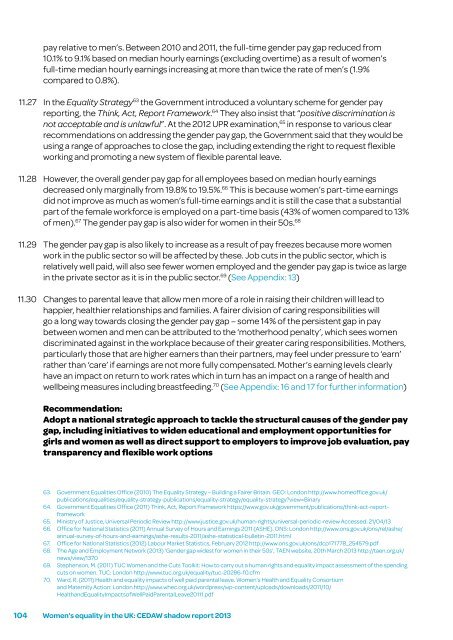Women’s equality in the UK – A health check
Women’s equality in the UK – A health check
Women’s equality in the UK – A health check
You also want an ePaper? Increase the reach of your titles
YUMPU automatically turns print PDFs into web optimized ePapers that Google loves.
11.27<br />
11.28<br />
11.29<br />
11.30<br />
pay relative to men’s. Between 2010 and 2011, <strong>the</strong> full-time gender pay gap reduced from<br />
10.1% to 9.1% based on median hourly earn<strong>in</strong>gs (exclud<strong>in</strong>g overtime) as a result of women’s<br />
full-time median hourly earn<strong>in</strong>gs <strong>in</strong>creas<strong>in</strong>g at more than twice <strong>the</strong> rate of men’s (1.9%<br />
compared to 0.8%).<br />
In <strong>the</strong> Equality Strategy 63 <strong>the</strong> Government <strong>in</strong>troduced a voluntary scheme for gender pay<br />
report<strong>in</strong>g, <strong>the</strong> Th<strong>in</strong>k, Act, Report Framework. 64 They also <strong>in</strong>sist that “positive discrim<strong>in</strong>ation is<br />
not acceptable and is unlawful”. At <strong>the</strong> 2012 UPR exam<strong>in</strong>ation, 65 <strong>in</strong> response to various clear<br />
recommendations on address<strong>in</strong>g <strong>the</strong> gender pay gap, <strong>the</strong> Government said that <strong>the</strong>y would be<br />
us<strong>in</strong>g a range of approaches to close <strong>the</strong> gap, <strong>in</strong>clud<strong>in</strong>g extend<strong>in</strong>g <strong>the</strong> right to request flexible<br />
work<strong>in</strong>g and promot<strong>in</strong>g a new system of flexible parental leave.<br />
However, <strong>the</strong> overall gender pay gap for all employees based on median hourly earn<strong>in</strong>gs<br />
decreased only marg<strong>in</strong>ally from 19.8% to 19.5%. 66 This is because women’s part-time earn<strong>in</strong>gs<br />
did not improve as much as women’s full-time earn<strong>in</strong>gs and it is still <strong>the</strong> case that a substantial<br />
part of <strong>the</strong> female workforce is employed on a part-time basis (43% of women compared to 13%<br />
of men). 67 The gender pay gap is also wider for women <strong>in</strong> <strong>the</strong>ir 50s. 68<br />
The gender pay gap is also likely to <strong>in</strong>crease as a result of pay freezes because more women<br />
work <strong>in</strong> <strong>the</strong> public sector so will be affected by <strong>the</strong>se. Job cuts <strong>in</strong> <strong>the</strong> public sector, which is<br />
relatively well paid, will also see fewer women employed and <strong>the</strong> gender pay gap is twice as large<br />
<strong>in</strong> <strong>the</strong> private sector as it is <strong>in</strong> <strong>the</strong> public sector. 69 (See Appendix: 13)<br />
Changes to parental leave that allow men more of a role <strong>in</strong> rais<strong>in</strong>g <strong>the</strong>ir children will lead to<br />
happier, <strong>health</strong>ier relationships and families. A fairer division of car<strong>in</strong>g responsibilities will<br />
go a long way towards clos<strong>in</strong>g <strong>the</strong> gender pay gap <strong>–</strong> some 14% of <strong>the</strong> persistent gap <strong>in</strong> pay<br />
between women and men can be attributed to <strong>the</strong> ‘mo<strong>the</strong>rhood penalty’, which sees women<br />
discrim<strong>in</strong>ated aga<strong>in</strong>st <strong>in</strong> <strong>the</strong> workplace because of <strong>the</strong>ir greater car<strong>in</strong>g responsibilities. Mo<strong>the</strong>rs,<br />
particularly those that are higher earners than <strong>the</strong>ir partners, may feel under pressure to ‘earn’<br />
ra<strong>the</strong>r than ‘care’ if earn<strong>in</strong>gs are not more fully compensated. Mo<strong>the</strong>r’s earn<strong>in</strong>g levels clearly<br />
have an impact on return to work rates which <strong>in</strong> turn has an impact on a range of <strong>health</strong> and<br />
wellbe<strong>in</strong>g measures <strong>in</strong>clud<strong>in</strong>g breastfeed<strong>in</strong>g. 70 (See Appendix: 16 and 17 for fur<strong>the</strong>r <strong>in</strong>formation)<br />
Recommendation:<br />
Adopt a national strategic approach to tackle <strong>the</strong> structural causes of <strong>the</strong> gender pay<br />
gap, <strong>in</strong>clud<strong>in</strong>g <strong>in</strong>itiatives to widen educational and employment opportunities for<br />
girls and women as well as direct support to employers to improve job evaluation, pay<br />
transparency and flexible work options<br />
63. Government Equalities Office (2010) The Equality Strategy <strong>–</strong> Build<strong>in</strong>g a Fairer Brita<strong>in</strong>. GEO: London http://www.homeoffice.gov.uk/<br />
publications/equalities/<strong>equality</strong>-strategy-publications/<strong>equality</strong>-strategy/<strong>equality</strong>-strategy?view=B<strong>in</strong>ary<br />
64. Government Equalities Office (2011) Th<strong>in</strong>k, Act, Report Framework https://www.gov.uk/government/publications/th<strong>in</strong>k-act-reportframework<br />
65. M<strong>in</strong>istry of Justice, Universal Periodic Review http://www.justice.gov.uk/human-rights/universal-periodic-review Accessed: 21/04/13<br />
66. Office for National Statistics (2011) Annual Survey of Hours and Earn<strong>in</strong>gs 2011 (ASHE). ONS: London http://www.ons.gov.uk/ons/rel/ashe/<br />
annual-survey-of-hours-and-earn<strong>in</strong>gs/ashe-results-2011/ashe-statistical-bullet<strong>in</strong>-2011.html<br />
67. Office for National Statistics (2012) Labour Market Statistics, February 2012 http://www.ons.gov.uk/ons/dcp171778_254579.pdf<br />
68. The Age and Employment Network (2013) ‘Gender gap widest for women <strong>in</strong> <strong>the</strong>ir 50s’, TAEN website, 20th March 2013 http://taen.org.uk/<br />
news/view/1370<br />
69. Stephenson, M. (2011) TUC Women and <strong>the</strong> Cuts Toolkit: How to carry out a human rights and <strong>equality</strong> impact assessment of <strong>the</strong> spend<strong>in</strong>g<br />
cuts on women. TUC: London http://www.tuc.org.uk/<strong>equality</strong>/tuc-20286-f0.cfm<br />
70. Ward, R. (2011) Health and <strong>equality</strong> impacts of well paid parental leave. <strong>Women’s</strong> Health and Equality Consortium<br />
and Maternity Action: London http://www.whec.org.uk/wordpress/wp-content/uploads/downloads/2011/10/<br />
HealthandEqualityImpactsofWellPaidParentalLeave20111.pdf<br />
104 <strong>Women’s</strong> <strong>equality</strong> <strong>in</strong> <strong>the</strong> <strong>UK</strong>: CEDAW shadow report 2013


